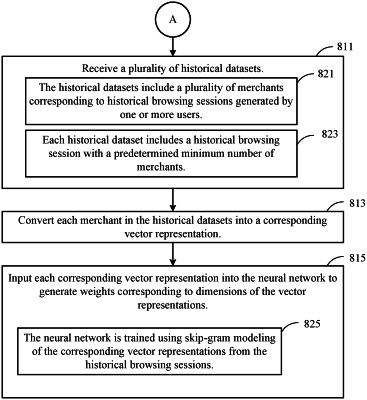| CPC G06Q 30/0255 (2013.01) [G06N 3/08 (2013.01)] | 20 Claims |

|
1. A server system comprising:
a memory; and
one or more processors, the processors configurable to cause:
training a neural network using a first training dataset such that a weighted vector space of a plurality of merchants is generated, the weighted vector space having a set of weights, each weight corresponding to one of a plurality of vector dimensions, the plurality of vector dimensions corresponding to a plurality of merchant features, wherein the neural network is trained by:
(i) inputting the first training dataset into an input layer of the neural network to generate the set of weights corresponding to the plurality of vector dimensions, the first training dataset including first groupings of merchant vectors having the plurality of vector dimensions, each merchant vector of the first groupings including a vector representation corresponding to one of the plurality of merchants, the first training set corresponding to at least one browsing session generated at one or more client devices, wherein each first grouping of merchant vectors corresponds to a plurality of context-target merchant pairs, each context-target merchant pair being associated with a context merchant and a target merchant,
(ii) for each first grouping, generating, using the corresponding plurality of context-target merchant pairs and at least one glossary of merchant vectors that maps each of the plurality of merchants to a corresponding one of a plurality of merchant vectors, for each context merchant of the first grouping, probability values for the plurality of merchants, each of the probability values characterizing an association between the merchant vector corresponding to the context merchant of the first grouping and the merchant vector corresponding one of the plurality of merchants, and
(iii) updating the weighted vector space using the probability values generated for each first grouping via backpropagation of associated errors,
inputting a first merchant vector of a new dataset into the input layer of the neural network, the first merchant vector being associated with a first merchant and having the plurality of vector dimensions, the new data set corresponding to a new browsing session generated at a first client device;
outputting, via an output layer of the neural network using the weighted vector space of the neural network, a set of merchants with corresponding merchant vectors having at least a threshold probability of association with the first merchant vector;
selecting a second merchant from the set of merchants based on a corresponding probability value generated using the weighted vector space, the probability value characterizing an association between the first merchant vector and a second merchant vector corresponding to the second merchant;
transmitting a first message to the first client device, wherein the first message identifies the second merchant;
generating a second training dataset, wherein the second training dataset represents user selection of one or more merchants in response to the first message, wherein the second training dataset includes second groupings of merchant vectors, wherein each second grouping of merchant vectors corresponds to at least one searched merchant and a selected merchant; and
training the neural network by updating the weighted vector space using the second training dataset by: performing backpropagation of errors associated with probability values generated based, at least in part, on the merchant vector corresponding to the selected merchant of the second grouping and merchant vectors corresponding to the at least one searched merchant of the second grouping.
|